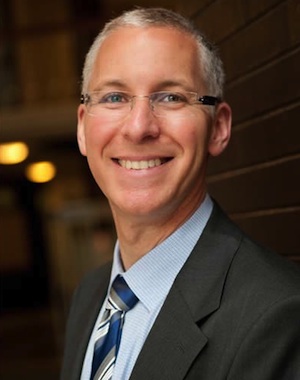
Dr. Larry White is certainly an accomplished physician. That's why he's UHN's recently appointed Radiologist-in-Chief in the Joint Department of Medical Imaging.
He's also the former Site Director of Medical Imaging at Mount Sinai Hospital and Head of the Musculoskeletal Division within the JDMI. He earned his medical degree from the University of Toronto and began his professional career 17 years ago at MSH.
But what's Larry White like behind the scenes? What's on his iPod? Where does he see the future of the JDMI? Check UHNews' one-on-one interview to find out.
UHNews: Growing up, did you always aspire to be a doctor?
Dr.
White:No, I didn't. In fact, I didn't know I wanted to go into medicine until I was in university! I was always attuned to physics, math and science but wasn't the greatest student until the end of high school. I noticed myself doing better in subjects that forced me to focus and work towards a solution, as opposed to the arts where the answers weren't quite as clearly defined.
Even as an undergrad, I didn't realize I was going to go into medicine until my second year when I applied and got into UofT's Medical School.
UHNews: What is the biggest challenge you are currently facing or expect to face as Radiologist-in-Chief?
Dr. White: A big challenge is getting used to all the different projects that our department is currently involved in. As key players in the patients' health care journey, we tend to focus on what's most relevant to us in our clinical divisions or in our areas of expertise. While this continues to be important items of focus, it is also important to keep abreast of the things happening throughout the JDMI and its partner hospitals. To continue being leaders in medical imaging, it is essential for us to adjust ourselves to our environment.
My biggest challenge right now is getting attuned with these varying demands and getting to speed with the things we've been successful doing to-date or we need to do better.
There are also the challenges which lie with Radiology in general. For example, "How are we as an academic department any different from any other radiology department in the country?" I believe it comes down to our subspecialty Radiology, exemplary quality-based patient care and ability to leverage our advanced skills to patients and the broader healthcare community. We need to compare our standards and quality with other hospitals and see exactly how we measure up.
UHNews: What do you hope to accomplish in this position?
Dr. White: I would like to take Radiology and the department into an exciting new direction where it can thrive and have the biggest impact.
UHNews: Who do you turn to for advice?
Dr. White: I wouldn't say there's any one person I turn to for advice. It's more a host of people consisting of friends, colleagues, even my kids - but more often than not, I turn to my wife. She's my closest friend and helps keep me honest.
UHNews: Can you think of a memorable or significant moment at the JDMI?
Dr. White: How supportive and empathetic everyone was last year when my father was diagnosed and shortly after passed away. Understanding this was a difficult time for me, the department and my colleagues were exceptionally supportive. This is when I realized how truly lucky I was, and how much working at the JDMI with my friends and colleagues meant to me.
UHNews: To you, what distinguishes the JDMI from all other medical imaging departments in Canada? Elsewhere?
Dr. White: The things that distinguish the JDMI are its people, its size and its profile on the evolution of healthcare's landscape, provincially and nationally. These are things we sometimes take for granted, but are important aspects of what sets us apart from most other diagnostic departments in the country.
UHNews: What are you most impressed with about the JDMI?
Dr. White: I am very impressed with how things have evolved from the merger amongst our various hospitals and departments over the years. While we still have some ways to go, the JDMI has a solid group of employees and talent base that are dedicated to advancing the quality of patient care we provide throughout our department and the hospitals we serve.
UHNews: What does the JDMI mean to you?
Dr. White:The JDMI to me is a mosaic of individuals that are passionate about and skilled in what they do. They work in an environment where they are encouraged to innovate and influence healthcare today and into the future.
Not including my residency training, I have spent over 17 years in this department - making the JDMI, very much my family.
UHNews: What's in your iPod?
Dr. White: My music tastes are quite varied, listening to everything from classical opera to pop. I'm particularly a fan of Radiohead, Florence and the Machine, U2 and the White Stripes. But I also enjoy listening to music I grew up on, including Bowie, Neil Young, Crosby, Stills and Nash, Elton John and Genesis.
UHNews: What keeps you awake at night?
Dr. White: Nothing! Although, I'll get excited about certain ideas and they may hit me at unconventional times…I generally have no problem sleeping as soon as my head hits the pillow.
UHNews: Where do you see the JDMI in five years?
Dr. White: I think in five years the JDMI is going to be recognized as a critical part of determining healthcare outcomes provincially. Instead of us relying on clinicians to order the right tests, we will be more involved at the onset of a patient's care. The JDMI will also be a key driver in the rationalization of how to better utilize our resources towards areas most impacting our patient populations.
Although I can't say what exactly the future is going to look like, I can say that the JDMI will have a very important role in where that future is going to be.
Related:
